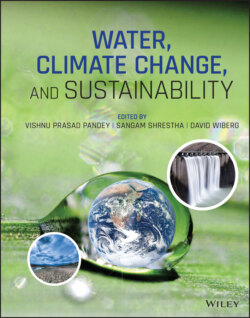Читать книгу Water, Climate Change, and Sustainability - Группа авторов - Страница 47
3.3.4. Energy Supply from Bio‐Based Systems
ОглавлениеBiomass has been identified as the most reliable potential source of energy and feedstock for the industrial sector until 2050 (United Nations Industrial Development Organization, 2019). Currently, biomass supplies 10% of the total energy demand, and 68% of this is in the form of fuelwood (World Energy Council, 2016). One third of energy use in pulp and paper industries is supplied by biomass and waste (United Nations Industrial Development Organization, 2019). Utilization of biomass as a feedstock is being expanded to the fuels and chemicals industries that used to be conventionally supplied by petroleum‐based sources. Based on the estimation by United Nations Industrial Development Organization (2019), by 2050, biomass can supply 37%, 25%, 18% and 10% of the total process heat in chemical and petrochemical, non‐metallic minerals, paper and pulp, and wood and woody products industries, respectively. In 2016, biomass was the only renewable source of liquid fuel in the transportation sector with 103 billion L of ethanol, 31 billion L of biodiesel and 5.9 billion L of hydrotreated vegetable oil produced globally, which contributed to only 0.3% of the total energy demand (REN21, 2018). However, an increase in bio‐based products from $203 billion worth in 2015 to $487 billion worth in 2024 was forecasted (Biotechnology Innovation Organization, 2017). Biofuels and biochemicals offer several advantages such as lower environmental impacts and product security when compared to depleting petroleum‐based fuels and chemicals, which drives the expansion of the bio‐based economy and incentivizes the development of bio‐based systems.
Table 3.3 Total energy use and energy use efficiency of oilseeds production.
Sources: Adapted from Ruiz‐Mercado, G. J., Smith, R. L., and Gonzalez, M. A. (2012). Khan, S., Khan, M. A., Hanjra, M. A., and Mu, J. (2009).
| Oilseed | Total energy use (MJ/t)* | Energy use efficiency (decimal)* | ||
|---|---|---|---|---|
| Average | SD** | Average | SD** | |
| Soybean | 9360 | 3248 | 2.43 | 0.79 |
| Canola | 5565 | 1124 | 4.24 | 1.40 |
| Carinata | 4340 | 1732 | 3.14 | 1.09 |
| Sunflower | 8532 | 2580 | 3.25 | 1.09 |
| Sesame | 1 5930 | 1793 | 1.57 | 0.19 |
* Data were collected from Canakci et al., 2004; Cardone et al., 2003; Hamzei and Seyyedi, 2016; Iriarte et al., 2010; Kallivroussis et al., 2002; Kusek et al., 2016; Mousavi‐Avval et al., 2017; Mousavi Avval et al., 2011; Pahlavan et al., 2012; Ramedani et al., 2011; World Energy Council, 2016.
** SD stands for standard deviation.
Figure 3.3 Energy use in different steps of biodiesel production from canola and carinata as the feedstock.
Source: Cardone, M., Mazzoncini, M., Menini, S. et al. (2003).
Figure 3.4 Interconnection of water‐energy and SDGs.
